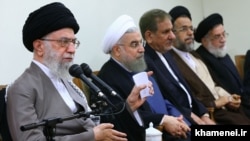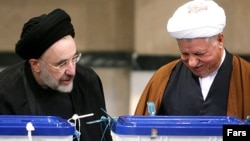In the past few weeks, public disagreements over major policy issues between President Hassan Rouhani and Ali Khamenei have become a routine occurrence.
Public statements by either one of these two politicians, soliciting an immediate response from the other, are not a recent phenomenon. What is new is that it has intensified since the presidential election in May.
The public disagreements between the recently re-elected Rouhani and the un-elected Supreme Leader cover a wide range of issues.
One of these issues is UNESCO’s 2030 educational document, which Rouhani’s first administration had accepted as a guideline in August 2016.
The document, adopted in May 2015 at the World Education Forum 2015, represents the firm commitment of countries and the global education community to a single renewed education agenda. The document highlights the importance of gender equality and inclusion in education.
On May 7, Khamenei suddenly brought this issue to the public’s attention by voicing his strong disagreement.
“The basis, in this country, is Islam and the Quran. This not a land where the defective, corrupt, and destructive Western lifestyle will be permitted to expand its influence,” he said.
Rouhani responded to this criticism on May 12 by assuring his supporters in a campaign rally that his government “will remain committed [to 2030] within the framework of Iranian culture and laws.”
Their battle over 2030 didn’t end there and continues almost on a daily basis.
But the main topic of disagreement is the direction of Iran’s worldview and foreign policy.
During the election campaign, and much more intensely after the elections, Khamenei repeatedly has called for vigilance against foreign influences and has warned against soft foreign policy, meaning the establishment of better relations with the United States.
This contrasted with Rouhani’s election platform, which advocated improving Iran’s ties with the rest of the world, without directly touching upon the almost forbidden issue of improving U.S.-Iranian relations. But Rouhani’s message was clear for his supporters who are fed up with Iran’s isolation and the subsequent economic hardships. They knew his message means normalization of ties with the West.
For those who very much desire change, Rouhani increasingly approaches the status of Khatami as a leader of reforms. These days, he speaks with more self-confidence and challenges Khamenei’s close clerical and military circles.
The epic clash of worldviews came to a head when Khamenei reiterated on June 4 his hard-line position.
“Challenging great powers is costly, but compromising with them has its own costs, as well,” he said.
Less than a week later, Rouhani responded to Khamenei in a speech saying that making peace needs more courage than confronting adversaries.
“Meek patience for the sake of peace is more difficult than stamina and perseverance on the battlefield,” he said.
As the public witnesses these squabbles, everyone realizes that in the context of the Islamic Republic, this degree of confrontation with the Supreme Leader by a president is unprecedented.
Although past presidents also had disagreements with Khamenei, they never dared to respond to him with this degree of clarity and directness.
On some occasions, former presidents might say something independent of Khamenei’s established policies, but usually they would hear his public response and then would either retreat or go into silent mode.
But the interesting observation is that two of these former presidents, Ali Akbar Hashemi Rafsanjani and Mohammad Khatami, who did not dare to disagree with Khamenei so much, were not rewarded. The Supreme Leader punished them both by imprisoning Hashemi’s children and putting travel and other restrictions on Khatami.
So, what is Rouhani betting on? Is he reassured because he got 57 percent of the vote in the May election? One can argue this big win was more a rejection of his main conservative rival than a full endorsement of his accomplishments.
It is safe to assume Rouhani will not be the winner of this confrontation. But will Khamenei limit himself just to a verbal conflict? One can think of several other possible reactions.
Mobilizing Supporters for a Physical Confrontation
One of Khamenei’s tactics in the past has been to give the green light to all sorts of conservative underlings to physically attack a non-docile politician. This has been done many times against prominent politicians such as parliament speaker, Ali Larijani or Khatami and a dozen others. During Khatami’s presidency, even assassination was used to destabilize the government, when Saeed Hajjarian, a top presidential adviser, was shot and wounded and the government became paralyzed.
Legal Action against Family Members and Key Assistants
In his four-decade political career, Khamenei has demonstrated he is a vengeful person when it comes to politics. Therefore, it is entirely possible he will use one of the state bodies under his control to hit back at Rouhani. One of these institutions is the judiciary, which can easily issue an arrest warrant for Rouhani’s brother, who is facing accusations of corruption. The same can be done with any one of the president’s top aides. The judiciary has always been a tool for Khamenei to take political revenge.
Political pressure
Political pressure can be another pressure tool in reaction to Rouhani’s talkativeness. Using any excuse, Khamenei’s loyalists can demand the firing of a top aide. Other tactics include persecution against students and the media or mob attacks on cinemas and public gatherings, such as concerts. Khamenei’s soft power army is ready for this and experienced.
Speculation or Reasonable Probability?
It is possible some readers will view the above-mentioned scenarios as nothing more than speculation. But we need to look at Khamenei’s track record. All the examples of pressure tactics mentioned are not ancient history. These happened in recent years under similar circumstances.
Just a few days ago, Khamenei reminded the public of Abolhassan Bani Sadr’s presidency. This is when the first elected president after the revolution distanced himself from the clerics and tried to stop persecution of the opposition. It ended with Bani Sadr fleeing the country.
This is how Khamenei started thinking about the current situation. He does not want to see a disloyal president – another Bani Sadr.
Mahmud Ahmadinejad was, of course, a different story. Khamenei did not feel threatened by him because he was not a cleric. But Rafsanjani, Khatami, and Rouhani are men of the cloth, and Khamenei thinks that if the people accept him as the top religious leader they could also accept another well-regarded cleric.
For those who very much desire change, Rouhani increasingly approaches the status of Khatami as a leader of reforms. These days, he speaks with more self-confidence and challenges Khamenei’s close clerical and military circles.
It seems improbable that the Supreme Leader will stand by and do nothing.














